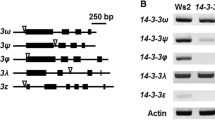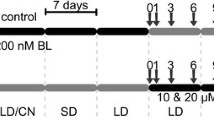Abstract
Key message
Arabidopsis gulliver3 - D/dwarf4 - D displays growth-promoting phenotypes due to activation tagging of a key brassinosteroid biosynthetic gene DWARF4. In gul3-D/dwf4-D , the Jasmonate and Salicylate signaling pathways were relatively activated and suppressed, respectively.
Abstract
Energy allocation between growth and defense is elegantly balanced to achieve optimal development in plants. Brassinosteroids (BRs), steroidal hormones essential for plant growth, are regulated by other plant hormones, including auxin and jasmonates (JA); auxin stimulates the expression of a key brassinosteroid (BR) biosynthetic gene, DWARF4 (DWF4), whereas JA represses it. To better understand the interaction mechanisms between growth and defense, we isolated a fast-growing mutant, gulliver3-D (gul3-D), that resulted from the activation tagging of DWF4, and examined the response of this mutant to defense signals, including JA, Pseudomonas syringae pv. tomato (Pst DC3000) infection, and wounding. The degree of root growth inhibition following MeJA treatment was significantly decreased in gul3-1D/dwf4-5D relative to the wild type, suggesting that JA signaling is partially desensitized in gul3-1D. Quantitative RT-PCR analysis of the genes involved in JA and salicylic acid (SA) responses, including MYC2, PDF1.2, CORI3, PR1, and PR2, revealed that JA signaling was preferentially activated in gul3-1D, whereas SA signaling was suppressed. As a result, gul3-1D was more susceptible to a biotrophic pathogen, Pst DC3000. Based on our results, we propose a model in which BR and JA cooperate to balance energy allocation between growth and defense responses. In ambient conditions, BRs promote plant growth; however, when stresses trigger JA signaling, JA compromises BR signaling by downregulating DWF4 expression.







Similar content being viewed by others
References
Benveniste P (1986) Sterol biosynthesis. Ann Rev Physiol 37:275–308
Boter M, Ruiz-Rivero O, Abdeen A, Prat S (2004) Conserved MYC transcription factors play a key role in jasmonate signaling both in tomato and Arabidopsis. Genes Dev 18(13):1577–1591
Cheon J, Park SY, Schulz B, Choe S (2010) Arabidopsis brassinosteroid biosynthetic mutant dwarf7-1 exhibits slower rates of cell division and shoot induction. BMC Plant Biol 10:270
Choe S (2004) Brassinosteroid biosynthesis and metabolism. In: Davies PJ (ed) Plant hormones: biosynthesis, signal transduction, action!. Kluwer Academic Publishers, Dordrecht, pp 156–178
Choe S, Dilkes BP, Fujioka S, Takatsuto S, Sakurai A, Feldmann KA (1998) The DWF4 gene of Arabidopsis encodes a cytochrome P450 that mediates multiple 22a-hydroxylation steps in brassinosteroid biosynthesis. Plant cell 10(2):231–243
Choe S, Dilkes BP, Gregory BD, Ross AS, Yuan H, Noguchi T, Fujioka S, Takatsuto S, Tanaka A, Yoshida S, Tax FE, Feldmann KA (1999a) The Arabidopsis dwarf1 mutant is defective in the conversion of 24-methylenecholesterol to campesterol in brassinosteroid biosynthesis. Plant Physiol 119(3):897–907
Choe S, Noguchi T, Fujioka S, Takatsuto S, Tissier CP, Gregory BD, Ross AS, Tanaka A, Yoshida S, Tax FE, Feldmann KA (1999b) The Arabidopsis dwf7/ste1 mutant is defective in the delta7 sterol C-5 desaturation step leading to brassinosteroid biosynthesis. Plant cell 11(2):207–221
Choe S, Fujioka S, Noguchi T, Takatsuto S, Yoshida S, Feldmann KA (2001) Overexpression of DWARF4 in the brassinosteroid biosynthetic pathway results in increased vegetative growth and seed yield in Arabidopsis. Plant J 26(6):573–582
Chung Y, Maharjan PM, Lee O, Fujioka S, Jang S, Kim B, Takatsuto S, Tsujimoto M, Kim H, Cho S, Park T, Cho H, Hwang I, Choe S (2011) Auxin stimulates DWARF4 expression and brassinosteroid biosynthesis in Arabidopsis. Plant J 66(4):564–578
Clouse SD, Sasse JM (1998) Brassinosteroids: essential regulators of plant growth and development. Annu Rev Plant Physiol Plant Mol Biol 49:427–451
Dombrecht B, Xue GP, Sprague SJ, Kirkegaard JA, Ross JJ, Reid JB, Fitt GP, Sewelam N, Schenk PM, Manners JM, Kazan K (2007) MYC2 differentially modulates diverse jasmonate-dependent functions in Arabidopsis. Plant Cell 19(7):2225–2245
Feys B, Benedetti CE, Penfold CN, Turner JG (1994) Arabidopsis mutants selected for resistance to the phytotoxin coronatine are male sterile, insensitive to methyl jasmonate, and resistant to a bacterial pathogen. Plant Cell 6(5):751–759
Fujioka S, Yokota T (2003) Biosynthesis and metabolism of brassinosteroids. Annu Rev Plant Biol 54:137–164
Fujioka S, Takatsuto S, Yoshida S (2002) An early C-22 oxidation branch in the brassinosteroid biosynthetic pathway. Plant Physiol 130(2):930–939
Glazebrook J (2005) Contrasting mechanisms of defense against biotrophic and necrotrophic pathogens. Annu Rev Phytopathol 43:205–227
Gray WM, Ostin A, Sandberg G, Romano CP, Estelle M (1998) High temperature promotes auxin-mediated hypocotyl elongation in Arabidopsis. Proc Natl Acad Sci USA 95(12):7197–7202
Ibanes M, Fabregas N, Chory J, Cano-Delgado AI (2009) Brassinosteroid signaling and auxin transport are required to establish the periodic pattern of Arabidopsis shoot vascular bundles. Proc Natl Acad Sci USA 106(32):13630–13635
Kim HB, Kwon M, Ryu H, Fujioka S, Takatsuto S, Yoshida S, An CS, Lee I, Hwang I, Choe S (2006) The regulation of DWARF4 expression is likely a critical mechanism in maintaining the homeostasis of bioactive brassinosteroids in Arabidopsis. Plant Physiol 140(2):548–557
Kim BK, Fujioka S, Takatsuto S, Tsujimoto M, Choe S (2008) Castasterone is a likely end product of brassinosteroid biosynthetic pathway in rice. Biochem Biophys Res Commun 374:614–619
Kwon M, Fujioka S, Jeon JH, Kim HB, Takatsuto S, Yoshida S, An CS, Choe S (2005) A double mutant for the CYP85A1 and CYP85A2 genes of Arabidopsis exhibits a brassinosteroid dwarf phenotype. J Plant Biol 48:237–244
Laurie-Berry N, Joardar V, Street IH, Kunkel BN (2006) The Arabidopsis thaliana JASMONATE INSENSITIVE 1 gene is required for suppression of salicylic acid-dependent defenses during infection by Pseudomonas syringae. Molecular plant-microbe interactions. Mol Plant Microbe Interact 19(7):789–800
Li J, Nagpal P, Vitart V, McMorris TC, Chory J (1996) A role for brassinosteroids in light-dependent development of Arabidopsis. Science 272(5260):398–401
Lorenzo O, Chico JM, Sanchez-Serrano JJ, Solano R (2004) Jasmonate-insensitive1 encodes a MYC transcription factor essential to discriminate between different jasmonate-regulated defense responses in Arabidopsis. Plant Cell 16(7):1938–1950
Maharjan PM, Choe S (2011) High temperature stimulates DWARF4 (DWF4) expression to increase hypocotyl elongation in arabidopsis. J Plant Biol 54(6):425–429
Maharjan PM, Schulz B, Choe S (2011) BIN2/DWF12 antagonistically transduces brassinosteroid and auxin signals in the roots of arabidopsis. J Plant Biol 54(2):126–134
Nemhauser JL, Mockler TC, Chory J (2004) Interdependency of brassinosteroid and auxin signaling in Arabidopsis. PLoS Biol 2(9):E258
Noguchi T, Fujioka S, Takatsuto S, Sakurai A, Yoshida S, Li J, Chory J (1999) Arabidopsis det2 is defective in the conversion of (24R)-24-methylcholest-4-En-3-one to (24R)-24-methyl-5alpha-cholestan-3-one in brassinosteroid biosynthesis. Plant Physiol 120(3):833–840
Pauly M, Keegstra K (2008) Cell-wall carbohydrates and their modification as a resource for biofuels. Plant J 54(4):559–568
Ren C, Han C, Peng W, Huang Y, Peng Z, Xiong X, Zhu Q, Gao B, Xie D (2009) A leaky mutation in DWARF4 reveals an antagonistic role of brassinosteroid in the inhibition of root growth by jasmonate in Arabidopsis. Plant Physiol 151(3):1412–1420
Souter M, Topping J, Pullen M, Friml J, Palme K, Hackett R, Grierson D, Lindsey K (2002) Hydra mutants of Arabidopsis are defective in sterol profiles and auxin and ethylene signaling. Plant cell 14(5):1017–1031
Szekeres M, Nemeth K, Koncz-Kalman Z, Mathur J, Kauschmann A, Altmann T, Redei GP, Nagy F, Schell J, Koncz C (1996) Brassinosteroids rescue the deficiency of CYP90, a cytochrome P450, controlling cell elongation and de-etiolation in Arabidopsis. Cell 85(2):171–182
Wang ZY, Seto H, Fujioka S, Yoshida S, Chory J (2001) BRI1 is a critical component of a plasma-membrane receptor for plant steroids. Nature 410(6826):380–383
Woeste KE, Ye C, Kieber JJ (1999) Two Arabidopsis mutants that overproduce ethylene are affected in the posttranscriptional regulation of 1-aminocyclopropane-1-carboxylic acid synthase. Plant Physiol 119(2):521–530
Yin Y, Wang ZY, Mora-Garcia S, Li J, Yoshida S, Asami T, Chory J (2002) BES1 accumulates in the nucleus in response to brassinosteroids to regulate gene expression and promote stem elongation. Cell 109(2):181–191
Yin Y, Vafeados D, Tao Y, Yoshida S, Asami T, Chory J (2005) A new class of transcription factors mediates brassinosteroid-regulated gene expression in Arabidopsis. Cell 120(2):249–259
Zheng XY, Spivey NW, Zeng W, Liu PP, Fu ZQ, Klessig DF, He SY, Dong X (2012) Coronatine promotes Pseudomonas syringae virulence in plants by activating a signaling cascade that inhibits salicylic acid accumulation. Cell Host Microbe 11(6):587–596
Acknowledgments
We would like to thank SuJeong Suh for technical assistance and Yanhai Yin for providing the anti-BES1 antibody, and Suguru Takatsuto for supplying deuterium-labeled internal standards. S.D.G. This work was supported by the grants, in part, from the Next-Generation BioGreen 21 Program (Plant Molecular Breeding Center No. PJ008051), Rural Development Administration, Republic of Korea; the Technology Development Program (110033-5) for Agriculture and Forestry, Ministry for Food, Agriculture, Forestry and Fisheries, Republic of Korea (to SC); the BK21 Research Fellowships, funded by the Ministry of Education, Science, and Technology of the Korean Government (to BK); and a Grant-in-Aid for Scientific Research (B) from the Ministry of Education, Culture, Sports, Science and Technology of Japan (no. 19380069 and 23380066 to SF).
Conflict of interest
The authors declare that they have no conflict of interest.
Author information
Authors and Affiliations
Corresponding author
Additional information
Communicated by J. R. Liu.
A contribution to the Special Issue: Plant Hormone Signaling.
Electronic supplementary material
Below is the link to the electronic supplementary material.
Rights and permissions
About this article
Cite this article
Kim, B., Fujioka, S., Kwon, M. et al. Arabidopsis Brassinosteroid-overproducing gulliver3-D/dwarf4-D mutants exhibit altered responses to Jasmonic acid and pathogen. Plant Cell Rep 32, 1139–1149 (2013). https://doi.org/10.1007/s00299-012-1381-2
Received:
Revised:
Accepted:
Published:
Issue Date:
DOI: https://doi.org/10.1007/s00299-012-1381-2




